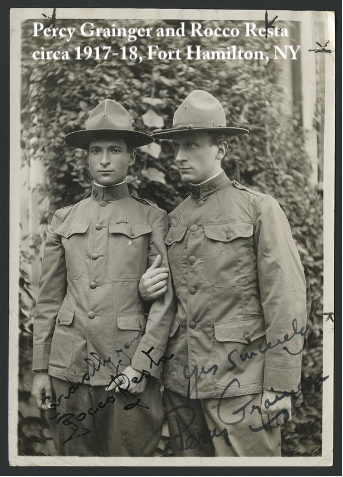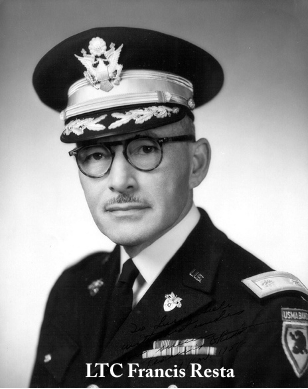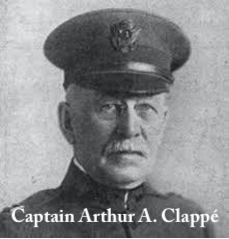
The 15th Band, Coast Artillery Corps, U.S. Army, Fort Hamilton, Brooklyn, 1917. Front row center, in civilian attire, is Arthur A. Clappé (faculty 1911-20), principal of the bandmaster training school on Governors Island. Rocco (Robert) Resta (Diploma ’13, Military Bandleaders Course), leader of the Fort Hamilton band, is second to the left of Clappé, holding a baton and his brother, Francis, who would later be the Bandmaster of the US Military Academy Band, is the clarinetist to the viewer’s far right. To Clappé's left is Australian composer and pianist Percy Grainger, Army bandsman at Fort Hamilton, who enlisted in 1917 and was later transferred to Governors Island. (Photo by J.J. Fisher, New York. From the collection of the Grainger Museum, University of Melbourne, Australia)
By William Garlette, Major, US Army (Retired). Most of Percy Grainger’s music for wind band was written or started between 1900 and 1940. During those years, there were three gentlemen who had a musical impact on him: Robert ‘Rocco’ Resta, Francis Resta, and Arthur A. Clappé. All three were members of the U.S. Army Band program and they all worked directly with Grainger.
Percy Grainger and his mother, Rose, came to the United States in 1914 in an effort to avoid military service during World War I. Additionally, the 1914-15 performance season had been cancelled in overseas due to the War. When the US entered the war in 1917, Grainger hoped to avoid ‘The Front’ by joining the 15th Coast Artillery Corps US Army Band at Fort Totten/Fort Hamilton. Bandmaster Robert ‘Rocco’ Resta, a 1913 graduate of the Army Band Leaders Course, Military Band Department, Institute of Musical Art (the forerunner of modern-day Juilliard), was his first opportunity to work directly with a professional US military band conductor. During his time with the 15th (1917-1918), he became close with Rocco and his younger brother, Francis, who was also a performing member of the band. These relationships would be life-long. 
Grainger respected Rocco’s musicianship, writing to his mother, Rose, on June 12, 1917, “Resta is a good & graceful conductor, very Italian, full of fine contrasts.” (1)
Later, he would write in his Round Letter of May 21, 1947, “For I have passed a mile-stone in my tone-life: Francis Resta’s forth-playment of my Hillsong 1 at West Point on April 20. Rocco Resta (Francis Resta’s brother) was my band-leader in the army, at Fort Hamilton, 1917-1918 --& I was happy there with Rocco. Francis Resta (younger brother) came to Fort Hamilton before I left there to go & teach tone-art in the ARMY MUSIC TRAINING SCHOOL at Governors Island, & he soon came on to Gov. Isl. Himself having won an army scholarship. So we were at Gov. Island together for nearly a year.” (2)
The musical cooperation between Grainger and the Resta brothers, especially Francis, is well-documented. On many occasions after Francis Resta assumed the position of Teacher of Music/Bandmaster of the West Point Band (1934-1957), Resta performed, read through new works, and had Grainger as a soloist at the US Military Academy. 
Grainger was reassigned to the Army Band Leaders Course, Military Band Department, Institute of Musical Art at Fort Jay, Governors Island, NY in 1918. This was mainly done because there was talk that the 15th C.A.C. Band was going to France and ‘The Front.’ It was here that he began working with Captain Arthur A. Clappé. Captain Clappé was the Principal of the Army Band Leaders School of Music from its inception in 1911 until his death in 1920. Clappé (3), along with John Phillip Sousa (4), was instrumental in getting Grainger into the 15th Coast Artillery Corps US Army Band in 1917 writing to senior Army commanders on his behalf.

Grainger was so impressed with Captain Clappé, he wrote in the publication, Metronome Orchestra Monthly (5), an essay entitled Possibilities of the Concert Wind Band from the Standpoint of a Modern Composer (6): “Those who are interested in exploring the full latent possibilities of the modern concert wind band should consult Arthur A. Clappé's The Wind Band and its Instruments, an epoch-making work which is to the band of today what Berlioz's Treatise on Instrumentation was to the orchestra of his time – a standard work that no composer, musician, bandmaster, or bandsman should fail to know and absorb.” (7)
He continues “…[Clappé] has furthermore demonstrated in practice the truth and practicability of his theories in the beautifully balanced ‘Institute of Musical Art’ Band that he has built up at the Army Music Training School at Governor’s Island of which he is principal. When I first heard this band, at a concert at Washington Irving High School, with its quintet of saxophones, its quartet of alto and bass clarinets, its quartet of oboes, bass oboe and bassoon, with the tone of its well-rounded brass section so proportioned and controlled so as never to (except for quite special intentional effects) obscure or over-blare the more subtly expressive sound colors of its unusually complete woodwind sections, I realized, more than ever before, the truly immense potentialities of the concert wind band as an emotional musical medium.” 
This experience with Clappé lead him to state, “It is not so much the wind band as it already is, in the various countries, that should engage the creative attentions of contemporaneous composers of genius, as the band as it should be and will be; for it is still in a pliable state as regards its make-up as compared with the more settled form of the sound-ingredients of the symphony orchestra.” (8)
After World War I, Grainger established himself as a composer of the highest level of prominence in the Wind Band genre composing over 30 works for the medium.
This article makes clear that his experiences in the Army and with the various military music leaders at the time, solidified his beliefs in the importance and approaches to writing for the modern wind band.
1 The all-round man: Selected letters of Percy Grainger, 1914–1961 Gillies, Malcolm & David Pear (eds), Oxford [England] : Clarendon Press ; New York : Oxford University Press, 1994. p. 40
2 ibid, p. 208
3 Drawn from James A. Milne, “Arthur A. Clappé”, an unpublished biography and a Letter from Arthur Clappé to Manuel Comulada, June 10, 1917, Grainger Museum
4 Letter from John Philip Sousa to General White, June 6, 1917, Grainger Museum
5 Metronome Orchestra Monthly 34/11, November 1918, p.22-3 Possibilities of the Concert Wind Band from the Standpoint of a Modern Composer
6 http://online.anyflip.com/wkyv/laeu/mobile/index.html
7 ibid
8 ibid
(To follow: a reprint, “Arthur A. Clappé”, a biography published in The Journal of the International Military Music Society - 'Band International'. Published in two parts: Volume 32 No. 1 - April 2010 and Volume 32 No. 2 - August 2010 by James A. Milne.)